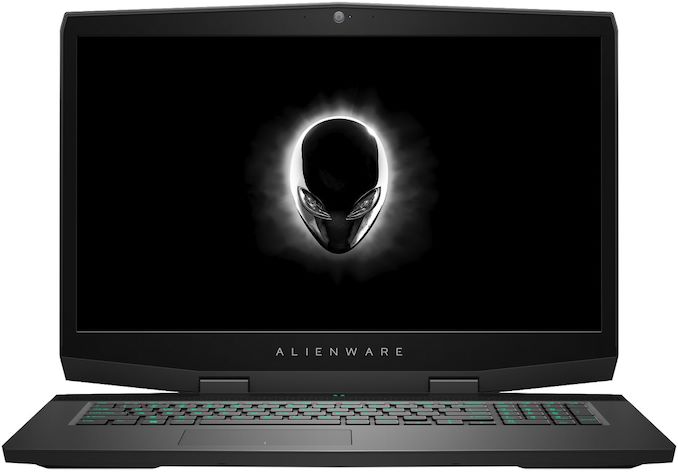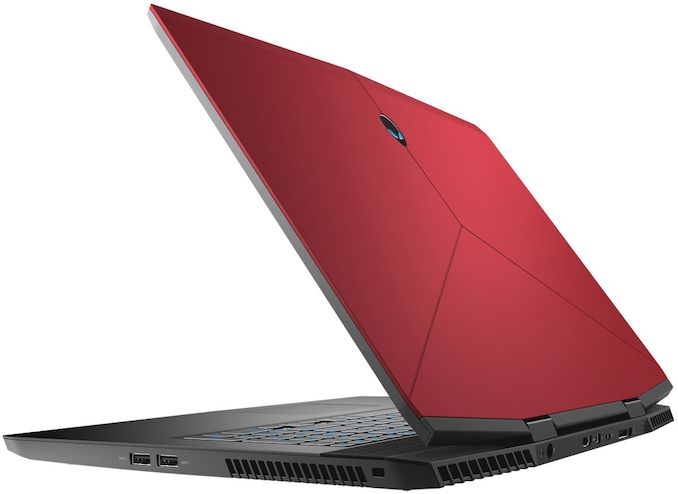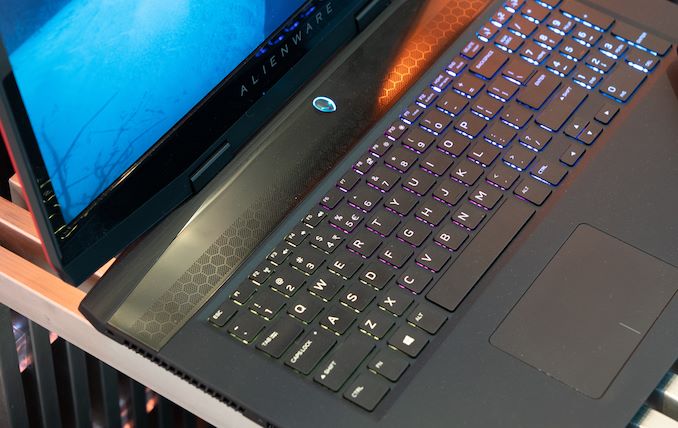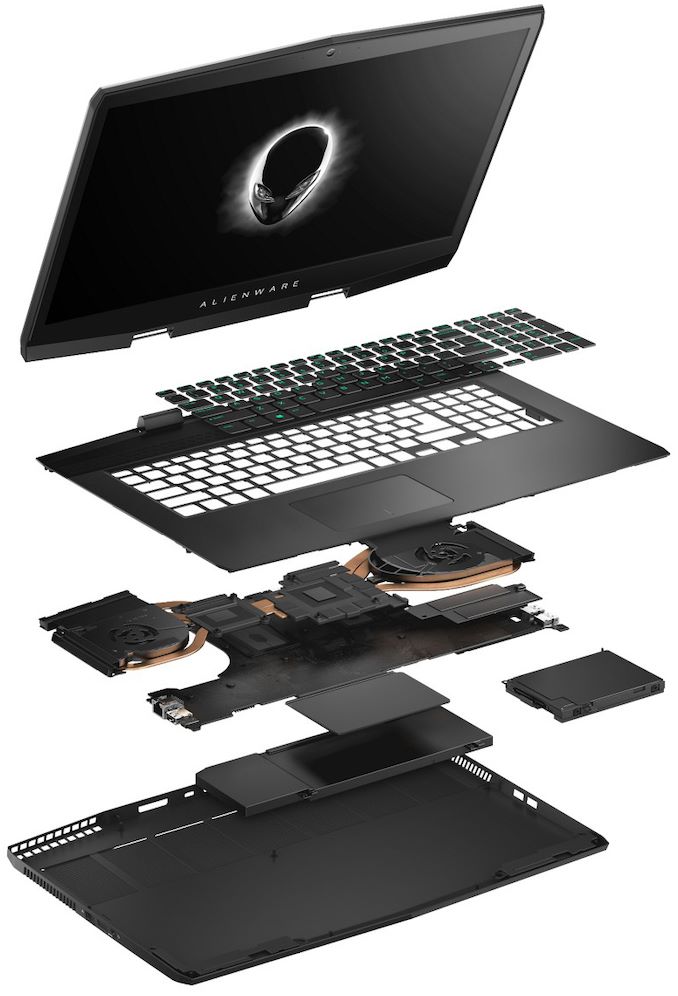Dell at CES 2019: Alienware m17 Packs Core i9, GeForce RTX into 17.3-Inch Chassis
by Anton Shilov on January 11, 2019 11:00 AM EST
Having launched Alienware m15 ultra-thin gaming laptops last year and updated them this week, Dell is rolling out more notebooks for gamers concerned about compact dimensions. The new Alienware m17 machines feature a 17.3-inch display and pack six-core processors paired with NVIDIA’s GeForce RTX 2080 Max-Q GPUs into a chassis that is up to 0.91 inch (23 mm) thick.
It goes without saying that the key feature of Alienware’s m17 laptop is its 17.3-inch display with a 1920×1080, 2560×1440, or 3840×2160 resolution. The Full-HD and Ultra-HD IPS panels feature a 60 Hz refresh rate, whereas the QHD TN panel features a 120 Hz refresh rate. Meanwhile, the higher-end 4K and QHD screens boast with 400 nits brightness, whereas the entry-level LCD is only rated for 300 nits brightness.
As far as internal hardware is concerned, the Alienware m17 notebook will use exactly the same components and configurations as the updated Alienware m15 introduced earlier this week. So, the the machine is powered by Intel’s latest mobile processor – including its six-core Core i9-8950HK CPUs – that are paired with NVIDIA’s GeForce GTX 1050 Ti, GeForce RTX 2060, RTX 2070 Max-Q, or 2080 Max-Q GPUs. Various Alienware m17 configs will feature from 8 to 32 GB of DDR4 memory and from 256 GB to 2 TB of PCIe/NVMe storage (see exact specs in the table below).
One important thing to note is that since the Alienware m17 notebook is bigger than the Alienware m15, it can be equipped with a larger and better cooling system. The latter enables the laptops to work at Turbo frequencies longer and thus provide higher performance in games.
When it comes to connectivity, the Alienware m17 copies its smaller brother too. The notebook has 802.11ac Wi-Fi + Bluetooth (from Qualcomm or Rivet Networks), a Killer E2500-enabled GbE port, one Thunderbolt 3 header, three USB 3.0 Type-A connectors, two display outputs (mini DisplayPort 1.3, HDMI 2.0), a 3.5-mm TRRS audio jack, and an Alienware Graphics Amplifier port for proprietary external graphics solutions. Besides, the Alienware m17 laptop features an RGB-backlit keyboard with a numpad, a 1080p webcam, stereo speakers, and a microphone array.
Just like the Alienware m15, the 17.3-inch notebook comes in Epic Silver or Nebula Red chassis that are from 18.5 to 23 mm thick (0.727 – 0.91 inches) thick. As for the weight, the Alienware m17 weighs 2.63 kilograms (5.79 pounds) when equipped with a 60 Wh battery or more when outfitted with a 90 Wh battery in a build-to-order configuration.
Sales of the Alienware m17 are set to begin on January 29, 2019. The price of the laptops will start at $1,650.
| General Specifications of Dell's Alienware m17 | ||||
| Alienware m17 1080p 60 Hz |
Alienware m17 1440p 120 Hz |
Alienware m17 4K UHD |
||
| Display | Type | IPS | TN | IPS |
| Resolution | 1920×1080 | 2560×1440 | 3840×2160 | |
| Brightness | 300 cd/m² | 400 cd/m² | ||
| Color Gamut | 72% NTSC (?) | ~100% sRGB | ||
| Refresh Rate | 60 Hz | 120 Hz | 60 Hz | |
| CPU | Intel Core i5-8300H - 4C/8T, 2.3 - 4 GHz, 8 MB cache, 45 W Intel Core i7-8750H - 6C/12T, 2.2 - 4.1 GHz, 9 MB cache, 45 W Intel Core i9-8950HK - 6C/12T, 2.9 - 4.5 GHz, 12 MB cache, 45 W |
|||
| Graphics | Integrated | UHD Graphics 620 (24 EUs) | ||
| Discrete | NVIDIA GeForce GTX 1050 Ti with 4 GB GDDR5 NVIDIA GeForce RTX 2060 with 6 GB GDDR6 NVIDIA GeForce RTX 2070 Max-Q with 6 GB GDDR6 NVIDIA GeForce RTX 2080 Max-Q with 8 GB GDDR6 |
|||
| RAM | 8 GB single-channel DDR4-2667 16 GB dual-channel DDR4-2667 32 GB dual-channel DDR4-2667 |
|||
| Storage | Single Drive | 256 GB PCIe M.2 SSD 512 GB PCIe M.2 SSD 1 TB PCIe M.2 SSD 1 TB HDD with 8 GB NAND cache |
||
| Dual Drive | 128 GB PCIe M.2 SSD + 1 TB (+8 GB SSHD) Hybrid Drive 256 GB PCIe M.2 SSD + 1 TB (+8 GB SSHD) Hybrid Drive 512 GB PCIe M.2 SSD + 1 TB (+8 GB SSHD) Hybrid Drive 1 TB PCIe M.2 SSD + 1 TB (+8 GB SSHD) Hybrid Drive 118 GB Intel Optane SSD + 1 TB (+8 GB SSHD) Hybrid Drive 256 GB PCIe M.2 SSD + 256 GB PCIe M.2 SSD 512 GB PCIe M.2 SSD + 512 GB PCIe M.2 SSD 1 TB PCIe M.2 SSD + 1 TB PCIe M.2 SSD |
|||
| Wi-Fi + Bluetooth | Default | Qualcomm QCA6174A 802.11ac 2x2 MU-MIMO Wi-Fi and Bluetooth 4.2 | ||
| Optional | Killer Wireless 1550 2x2 802.11ac and Bluetooth 5.0 | |||
| Thunderbolt | 1 × USB Type-C TB3 port | |||
| USB | 3 × USB 3.1 Gen 1 Type-A | |||
| Display Outputs | 1 × Mini DisplayPort 1.3 1 × HDMI 2.0 |
|||
| GbE | Killer E2500 GbE controller | |||
| Webcam | 1080p webcam | |||
| Other I/O | Microphone, stereo speakers, TRRS audio jack, trackpad, Alienware Graphics Amplifier port, etc. | |||
| Battery | Default | 60 Wh | ||
| Optional | 90 Wh | |||
| Dimensions | Thickness | 18.5 mm | 0.727 inch ~ 23 mm | 0.91 inch | ||
| Width | 410 mm | 16.1 inch | |||
| Depth | 292.5 mm | 11.52 inch | |||
| Weight (average) | 2.63 kilograms | 5.79 lbs | |||
| Operating System | Windows 10 or Windows 10 Pro | |||
Related Reading:
- Alienware Rolls Out Thin & Powerful m15 Laptop: Coffee Lake & GTX 1070 Plus 4K
- Eurocom Launches Tornado F7W DTR Laptop: Desktop Core i9-9900K with 128 GB of RAM
- Dell's Spring Range: New 8th Gen Alienware, Laptops, and Monitors
- Alienware Refreshes The Alienware 15 And 17 Gaming Notebooks At PAX
- Eurocom Launches Sky X4C, X7C and X9C Laptops with Core i7-8700K CPUs
Source: Dell















18 Comments
View All Comments
mmrezaie - Friday, January 11, 2019 - link
such an ugly design but I am seeing no intake from the bottom? this is good news. If only they could have a better keyboard and less noise on the next xps 15 (with no bottom intake) then I will consider trying it again.DanNeely - Friday, January 11, 2019 - link
Yeah, the blowers appear to be in from the side out the back, or vice versa.Opencg - Friday, January 11, 2019 - link
Not a fan a thin max q models. Even the "fat" laptops are hit or miss on throttling let alone default power limits for max q are about half of normal. They all have hidden or undisclosed performance limits. For over the price of another 2080 gaming laptop you can have half the performance? Why? Waiting on the fat option. I heard it actually has a socketed cpu this time. Though if I know dell its just a stunt to regain people they lost and the system will still be about tricking consumers. Clevo for the win I guess.PeachNCream - Friday, January 11, 2019 - link
Underside fan intakes suck (pun intended) for on-lap use so I totally agree that pulling from a side is better for actually using a laptop on a lap but that thin chassis packed with all of that hot running hardware might still get too warm for on-lap use. We'll have to wait for a review that measures underside temps at load.HStewart - Friday, January 11, 2019 - link
I think the Ugly nature of device is basically and issue with all gaming notebooks lately - but this one looks a lot thinner than ones on past - but Alienware is under Dell and Dell has done a lot of work on making laptops have better cooling - my XPS 13 2in1 virtually is quite all the time, but XPS 15 2in1 is much louder - but still does not generate much heat - not sure if issue with 4Ghz CPU or and/or the GPU on it. But this time next year, I would bet we have same level notebook as this one in side of XPS 15 2in1 and much quitter - especially with Sunny Cove - hopefully GPU will be better also.wr3zzz - Friday, January 11, 2019 - link
Doesn't XPS 13 2in1 use the y-seies CPU and is fanless? Shouldn't it be quite all the time and not just virtually?KateH - Friday, January 11, 2019 - link
i have to question how well a RTX 2070 / 2080 is going to fare in a chassis like this... looks to be the same thickness and almost identical cooling system to my MSI GE72, and that struggles to cool an i7 6700HQ and GTX 960M. I've read about Max-Q in an attempt to wrap my head around it but every explanation I've seen boils down to "it's magic! trust Nvdia!" It looks to be more than just lower GPU clocks, is there super strict binning going on there too?On a sidenote, I can't be the only one who would like to see more gamer/power user focused 17" Ultrabooks. Not "thin and light" like this or my MSI but ultrabook as in < 3/4" at the thickest, good display with full sRGB, i7 8xxxU or (preferably) R7 3700U in 25W DP-up mode with enough cooling to stay at high turbo, and a Thunderbolt port for eGPU. That would be my ideal notebook but the only thing i know of that comes close is the LG Gram 17.
PeachNCream - Friday, January 11, 2019 - link
Max-Q does seem like a branding label sitting atop a variety of different methods that reduce thermal load. I haven't seen a lot from NVIDIA on the specifics, but performance does tend to be a bit lower than the non-Max-Q variant of the same dGPU. As an aside, I think Max-Q branding is ultimately going to fade into obscurity since it looks like lots of OEMs are opting for the cooler/lower heat GPUs to the point that they might end up becoming the standard versions.In regards to your side note, you're not the only one. However Ultrabooks are already rather expensive even without dedicated graphics. Adding gaming hardware and the associated price premium will probably result in niche systems that will discourage a large portion of potential buyers. I think the limited appeal is what ultimately will hold OEMs back from doing more than dabbling around in that realm.
Opencg - Sunday, January 13, 2019 - link
Max q is about half the normal tdp limit. Aka half the performnce.Spunjji - Monday, January 14, 2019 - link
Why say something that can be so easily disproven? Have a look at the info on Notebookcheck, particularly for the 1060 and 1070 vs. their Max-Q variants. Going from the 1070 Max-Q to the standard 1070 gives you 18% more performance for a 33% increase in TDP.Max-Q designs run closer to the efficiency sweet-spot of the architecture. Personally I think they massively overcharge for that "privilege", but this is Nvidia and they have no competition in that market.